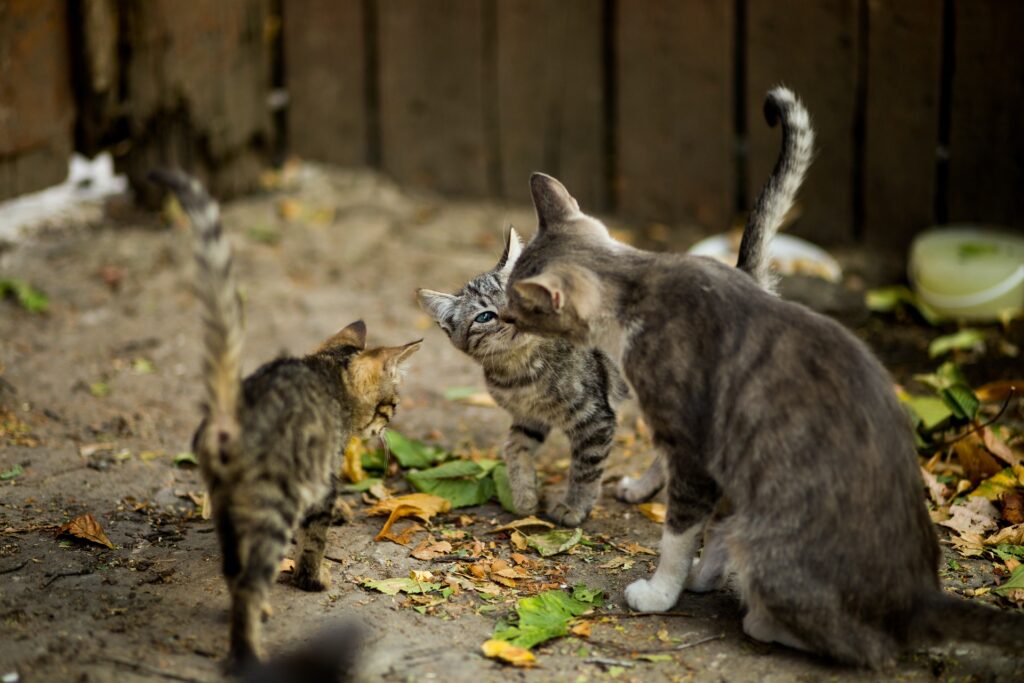
Did you know that domestic cats…
… are the only* cat species that uses the “tail up” signal?
A vertically raised tail is a housecat’s sign of friendly intentions. When two cats meet, often the one who is lower in the hierarchy (or feels in a weaker position) raises its tail first.
Cats also use this signal of affiliation towards people.
The wild cats from which the domestic cat is derived do not use the “tail up” signal. One theory is that it evolved in ancient Egypt, where cats were bred in large groups (an unnatural situation for wild cats), and a clear signal of friendly intentions let them avoid unnecessary conflicts.
… prefer different toys depending on whether they are hungry?
When cats are hungry, they are more likely to attack larger prey. A similar effect can be seen in the context of play – cats usually prefer mouse-sized toys, but when hungry they choose rat-like toys. In wild animals, hunger tends to lower the desire to play altogether.
This shows that playing and hunting are very similar for domestic cats.
… are less aggressive when given the opportunity to play?
Too little play and a non-stimulating environment can contribute to aggression in cats (and dogs).
Even adult cats need to play, although they usually only want to do so for 2-3 minutes at a time. If you would like to play with your cat longer, wait for him/her to initiate the interaction. Research suggests that when the cat, rather than a human, initiates play, the interaction usually lasts longer. Other research shows that cats prefer a man-operated “fishing rod” to unanimated toys, and of course new toys are more interesting than old ones**.
Additionally, playing with a “fishing” toy reduces cats’ tendency to hunt wild animals.
However, remember to make the “hunting” successful, by providing some food once a while when the cat catches the “prey” and at the end of the play session.
… can use catnip as mosquito repellant?
Many cats (including wild cats, such as lynx, leopard and lion) react vigorously to catnip. They rub their head against the plant and roll in it. The smell of catnip activates the reward system in cats and the secretion of endorphins, similarly to opium’s effect in humans. However, catnip is not addictive to cats and is often added to toys by manufacturers.
It seems that the reaction to catnip is not only about euphoria. Catnip contains substances that repel mosquitoes and other insects. When rubbing against the plants these substances are transferred to the cat’s fur and it becomes less attractive to mosquitoes and other insects.
Cats hunt from ambush, by slowly sneaking up to their prey and waiting for the right moment to attack. While doing that they are an easy target for mosquitoes, which is why catnip-based repellant is a great solution (by the way, substances in catnip also repel mosquitoes when applied to human skin).
I have described the results of various scientific studies, which mostly describe general trends. Of course, your individual cat may behave differently or have different preferences, for example due to personality, experience or breed.
* One exception is that lions – the only wild cats that live in groups – also raise their tails in some affiliative interactions with others. Nevertheless, I never saw lion’s tail raised as highly as domestic cat’s tail. This behavior has certainly evolved independently in domestic cats.
** Small suggestion from me: to prevent cats (and other pets) from getting bored with all their toys, it’s a good idea to hide some of them away. After some days/weeks/months you hide different toys and return the old ones, that now become attractive.
